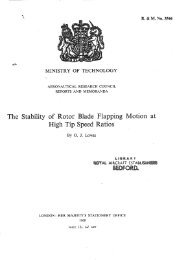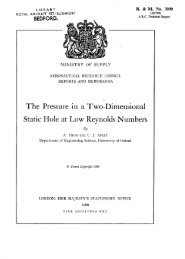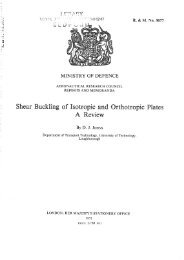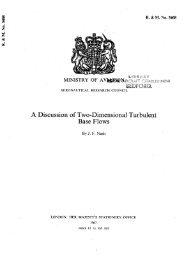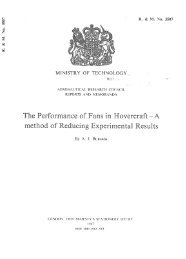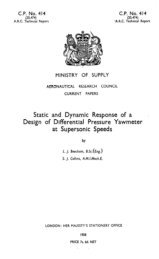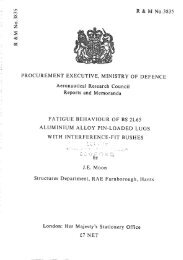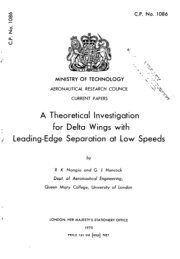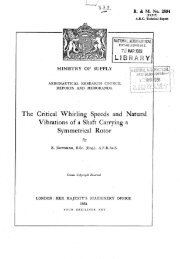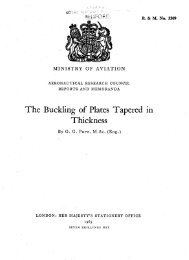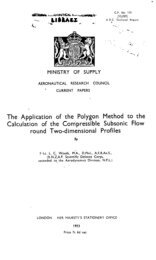The Influence of Surface Waves on the Stability of a ... - aerade
The Influence of Surface Waves on the Stability of a ... - aerade
The Influence of Surface Waves on the Stability of a ... - aerade
Create successful ePaper yourself
Turn your PDF publications into a flip-book with our unique Google optimized e-Paper software.
<str<strong>on</strong>g>The</str<strong>on</strong>g> fact that waves <strong>on</strong> <strong>the</strong> sirface, by disturbing <strong>the</strong> velocity<br />
pr<str<strong>on</strong>g>of</str<strong>on</strong>g>ile in a periodic manner, <strong>the</strong>mselves provxle a potential instability,<br />
has not been c<strong>on</strong>sidered in <strong>the</strong>se calculati<strong>on</strong>s, since It is assumed that<br />
sufficient sucti<strong>on</strong> ~111 be applied to damp out all oscillati<strong>on</strong>s whatever<br />
<strong>the</strong>ir source. Thus <strong>the</strong> results obtalned are fundamentally different from<br />
those <str<strong>on</strong>g>of</str<strong>on</strong>g> Fage6, which express <strong>the</strong> m~ax~mum permissible wave height in<br />
terms <str<strong>on</strong>g>of</str<strong>on</strong>g> <strong>the</strong> length <str<strong>on</strong>g>of</str<strong>on</strong>g> lamlnar fXoTTr before transiti<strong>on</strong>, and Reynolds number,<br />
<strong>on</strong> an aer<str<strong>on</strong>g>of</str<strong>on</strong>g>oll without sucti<strong>on</strong>. in Fag?' s case <strong>the</strong> waves <strong>the</strong>mselves are<br />
resp<strong>on</strong>sible for <strong>the</strong> Instability.<br />
<str<strong>on</strong>g>The</str<strong>on</strong>g> behaviour <str<strong>on</strong>g>of</str<strong>on</strong>g> <strong>the</strong> boundary layer in <strong>the</strong> limit<br />
v<br />
when $ = 0 is<br />
not given by <strong>the</strong>se calculati<strong>on</strong>s, since asymptotic c<strong>on</strong>diti<strong>on</strong>s cannot <strong>the</strong>n<br />
occur. In fact Quick and Schroder7 have shown that separati<strong>on</strong>wlll occur<br />
fairly rapidly for vraves <str<strong>on</strong>g>of</str<strong>on</strong>g> sufficient 'size' k .<br />
In c<strong>on</strong>trast to <strong>the</strong> effect <str<strong>on</strong>g>of</str<strong>on</strong>g> surface ~otubersnces', which becomes<br />
more serious as sucti<strong>on</strong> is Increased, It I.S seen that <strong>the</strong> destabilising<br />
effect <str<strong>on</strong>g>of</str<strong>on</strong>g> surface 'rraves ~3 alleviated by Increased suctl<strong>on</strong>. Presumably<br />
for a surface not completely clean aerodynamically, and c<strong>on</strong>taxnmng waves,<br />
a compromise must be found be+xrsen <strong>the</strong> ti,o requirements. <str<strong>on</strong>g>The</str<strong>on</strong>g>re 1s also<br />
<strong>the</strong> psslbllity <str<strong>on</strong>g>of</str<strong>on</strong>g> a res<strong>on</strong>ance effect between <strong>the</strong> perzodlcity <str<strong>on</strong>g>of</str<strong>on</strong>g> <strong>the</strong><br />
p<str<strong>on</strong>g>of</str<strong>on</strong>g>ile and <str<strong>on</strong>g>of</str<strong>on</strong>g> <strong>the</strong> surface itself, for 'iavc numbers near <strong>the</strong> crltxal.<br />
Some calclitati<strong>on</strong>s <str<strong>on</strong>g>of</str<strong>on</strong>g> <strong>the</strong> sucti<strong>on</strong> qwirtitws for irhlch this might occur are<br />
given in Appendix III.<br />
No.<br />
1<br />
2<br />
3<br />
4<br />
5<br />
6<br />
7<br />
Author<br />
P.R. &en, and<br />
L. luanfer<br />
C.C. Lin<br />
P. Chiarulli, and<br />
J.C. Freeman<br />
G.V. Lachmann,<br />
N. Gregory, and<br />
W.S. '!'alker<br />
J. Pretsch<br />
A. Fage<br />
A.vJ. Quick, and<br />
K. Schroder<br />
RXFFXFNCES<br />
Title, etc.<br />
<str<strong>on</strong>g>The</str<strong>on</strong>g> effect <str<strong>on</strong>g>of</str<strong>on</strong>g> xsolated roughness <strong>on</strong> boundary<br />
layer transitI<strong>on</strong>. (;Tnpublished)<br />
ARC 16,458, Xzch 1753<br />
On <strong>the</strong> stability <str<strong>on</strong>g>of</str<strong>on</strong>g> D,?o dimensx<strong>on</strong>al parallel<br />
flows.<br />
Q. APP. Xath 1, 1174L+2, 218-234, 277-301.<br />
4945-46<br />
<strong>Stability</strong> <str<strong>on</strong>g>of</str<strong>on</strong>g> <strong>the</strong> boundary layer.<br />
Technical Report F-TR-1197-IA,<br />
Wight-Patters<strong>on</strong> Air Force Base, August 1948<br />
Handley Page Lamlnar Flow lying with Porous<br />
Strips: Details <str<strong>on</strong>g>of</str<strong>on</strong>g> Model and '%nd Tunnel<br />
Tests at N.P.L.<br />
A.R.C. 14,794, Pky 1952<br />
<str<strong>on</strong>g>The</str<strong>on</strong>g> stablllty <str<strong>on</strong>g>of</str<strong>on</strong>g> two dlmensl<strong>on</strong>al lannnar<br />
flow with pressure drop and pressure rise.<br />
J



